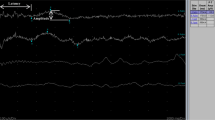Abstract
The sympathetic skin response (SSR) originates from synchronized activation of the sweat glands as a response to a volley discharge in efferent sympathetic nerve fibres. The aim of the study was to verify the diagnostic value of SSR in patients with reflex sympathetic dystrophy (RSD). SSR was recorded in 20 normal subjects and in 24 patients with predominantly chronic RSD. In normal subjects inter- and intra-individually different mono-, bi- and triphasic potentials could be recorded without difference of the waveform from side to side. SSR abnormalities were found in 15 patients and correlated with the severity of the disease. In patients with slight dystrophies, SSR was predominantly normal. In intermediate dystrophies, mainly differences of the SSR waveform between sides could be recorded, indicating unilateral sudomotor dysfunction. In severe dystrophies abnormalities of SSR amplitude or latency were found, indicating more serious disturbance of sudomotor activity, possibly due to a lesion of sympathetic fibres. The SSR provides useful information on sudomotor dysfunction in patients with RSD. However, as there is no consensus in the literature for the clinical criteria to diagnose RSD, it is not yet possible to determine the final diagnostic value of SSR for the diagnoses of RSD.
Similar content being viewed by others
References
Schwartzman RJ, McLellan MC. Reflex sympathetic dystrophy, a review.Arch Neurol 1987;44: 555–561.
Blumberg H, Griesser HJ, Hornyak M. Neurologische Aspekte der Klinik, Pathophysiologie und Therapie der sympathischen Reflexdystrophie.Nervenarzt 1991;62: 205–211.
Jänig W, Schmidt RF.Reflex Sympathetic Dystrophy. Weinheim: VHC, 1992.
Jänig W, Blumberg H, Boas RA, Campbell JN. The reflex sympathetic dystrophy syndrome, consensus statement and general recommendations for diagnosis and clinical research. In: Bond MR, Charlton JE, Woolf JC, eds.Pain Research and Clinical Management: Proceedings on the IV World Congress on Pain, Vol 4. Amsterdam: Elsevier, 1991; 372–375.
Schwartzman RJ. Reflex sympathetic dystrophy.Curr Opin Neurol Neurosurg 1993;6/4: 531–536.
Scola E, Schliack H. Das posttraumatische Sudeck-Syndrom.Dtsch Årztebl 1991;88: 1888–1890.
Procacci P, Francini F, Maresca M, Zoppi M. Skin potential and EMG changes induced by cutaneous electrical stimulation. II. Subjects with reflex sympathetic dystrophies.Appl Neurophysiol 1979;42: 125–134.
Cronin KD, Kirsner RLG. Diagnosis of reflex sympathetic dysfunction. Use of skin potential response.Anaesthesia 1982;37: 848–852.
Moberg E. Examination of sensory loss by the ninhydrin printing test in Volkmann's contracture.Bull Hosp Goint Dis 1960;21: 2.
Stöhr M, Dichgans J, Diener HC, Buettner UW, eds. In:Evozierte Potentiale. Berlin, Heidelberg, New York: Springer, 1982, 61–251.
Knezevic W, Bajada S. Peripheral autonomic surface potential — a quantitative technique for recording sympathetic conduction in man.J Neurol Sci 1985;67: 239–251.
Tarchanoff G. Über die galvanischen Erscheinungen an der Haut des Menschen bei Reizung der Sinnesorgane und bei verschiedenen Formen der physischen Tätigkeit.Pflugers Arch Ges Physiol 1890;46: 46–55.
Boucsein W.Elektrodermale Aktivität. Berlin, Heidelberg: Springer; 1988.
Baba M, Watahiki Y, Matsunaga M, Takebe K. Sympathetic skin response in healthy man.Electromyogr Clin Neurophysiol 1988;28: 277–283.
Elie B, Guiheneuc P. Sympathetic skin response in different experimental conditions.Electroencephalogr Clin Neurophysiol 1990;76: 258–267.
Faig J, Tegenthoff M, Hüppe D. Autonome Funktions-parameter bei sensomotorischen Polyneuropathien.Akt Neurol 1991;18: 163–168.
Schwalen S, Jörg J. Peripher Autonome Potentiale: Methodik, Normwerte und Wertigkeit bei Erkrankungen des zentralen oder peripheren Nervensystems. In: Huffmann G, ed.Läsionen des Peripheren Nervensystems. Reinbeck: Eichhorn, 1992, 73–80.
Hoeldtke RD, Davis KM, Hsieh PBet al. Autonomic surface potential: assessment of reproducibility and sensitivity.Muscle Nerve 1992;15: 926–931.
Martyn CN, Reid W. Sympathetic skin response.J Neurol Neurosurg Psychiat 1985;48: 490.
Francini F, Zoppi M, Maresca M, Proccaci P. Skin potential and EMG changes induces by cutaneous electrical stimulation. I. Normal man in arousing and non-arousing environment.Appl Neurophysiol 1979;42: 113–124.
Shahani B, Halperin JJ, Boulu P, Cohen J. Sympathetic skin response — a method of assessing unmyelinated axon dysfunction in peripheral neuropathies.J Neurol Neurosurg Psychiat 1984;47: 536–542.
Uncini A, Pullmann SL, Lovelace RE, Gambi D. The sympathetic skin response: Normal values, elucidation of afferent components and application limits.J Neurol Sci 1983;87: 299–306.
Yokota T, Matsunaga T, Okiyama R, Hirose K, Tanabe Het al. Sympathetic skin response in patients with multiple sclerosis compared with patients with spinal cord transsection and normal controls.Brain 1991;114: 1381–1394.
Tahmoush AJ, Malley J, Jennings JR. Skin conductance, temperature and blood flow in causalgia.Neurology 1983;33: 1483–1486.
Levy DM, Reid G, Rowley DA, Abraham RR. Quantitative measures of sympathetic skin response in diabetes.J Neurol Neurosurg Psychiat 1992;55: 902–908.
Yokota T, Takahashi T, Kondo Met al. Studies on the diphasic wave form of the galvanic skin reflex.Electroencephalogr Clin Neurophysiol 1959;11: 687–696.
Author information
Authors and Affiliations
Rights and permissions
About this article
Cite this article
Rommel, O., Tegenthoff, M., Pern, U. et al. Sympathetic skin response in patients with reflex sympathetic dystrophy. Clinical Autonomic Research 5, 205–210 (1995). https://doi.org/10.1007/BF01824008
Received:
Accepted:
Published:
Issue Date:
DOI: https://doi.org/10.1007/BF01824008




